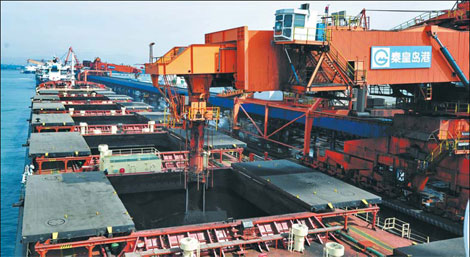China major ports face coal oversupply
 0 Comment(s)
0 Comment(s) Print
Print E-mail Xinhua, July 3, 2012
E-mail Xinhua, July 3, 2012
 |
|
A shipment of coal at Qinhuangdao, a major port in Hebei province. [Photo/China Daily] |
Coal inventories in Qinhuangdao, Tangshan and Huanghua, China's major coal ports, have reached record highs in recent days, sparking safety concerns for the Chinese energy market.
According to the latest figures, coal supplies among the three ports totaled 18.3 million tons on June 30, or 8.6, 8.4 and 1.3 million tons, respectively.
Qinhuangdao Port, located in north China's Hebei province, is the world's largest coal loading port, and it handles half of China's coal needs.
On June 25, the coal inventory in storage at Qinhuangdao totaled 9.08 million tons, while the designed volume for pile is 10.18 million tons.
The pile at Qinhuangdao was started in May. On June 18, coal inventories at this port hit 9.46 tons, the highest level since November 2008, according to official statistics.
At the port of Tangshan, which is also strategically located in Hebei in order to transport coal from northern to southern China, the coal inventory on June 25 totaled 8.1 million tons, just shy of the maximum volume of 8.7 million tons.
"China's coal stocks are estimated at about 300 million tons, equivalent to the entire country's coal consumption in one month," said Li Xin, a senior official with the China Coal Transportation and Distribution Association.
Industry insiders say that the slowdown in domestic economic growth reduced demand for thermal coal in China, which was caused by overcapacity in coal's downstream industries, including the steel, cement, electricity and real estate industries.
Moreover, China imported 86.55 million tons of coal in the first four months, up nearly 70 percent year-on-year.
"The increase of imported coal affected the price of domestic coal, as well as the domestic coal market," said Song Xinting, vice president of the Coal Transportation and Distribution Association of Hebei province.
According to statistics from the National Energy Administration, China's power consumption in the first five months of this year was 1.96 trillion kilowatt hours, up 5.8 percent year-on-year, but the growth rate fell 6.2 percentage points from the same period of last year.
As the southern parts of China have seen plentiful rainfall this year, hydropower generation output has increased. Meanwhile, in the eastern areas of China, natural gas has been used for generating electricity this year, another factor trimming thermal coal demand, Song added.
Due to these factors, the price of 5,500 Kcal thermal coal, part of the Bohai-Rim Steam-Coal Price Index, dropped to 729 yuan ($115) on June 25, resulting in the biggest weekly decrease since the index was launched.
In light of slowing economic growth and waning coal demand, a slowdown trend for coal supply and demand in the third quarter, or the second half of this year, will continue, industry insiders say.
Although thermal coal demand will increase over the peak power consumption period that runs from July to August, the massive coal inventories in power plants and ports won't change, industry insiders say.
So far, there has been no concrete action to cope with the problem.
Coal industry associations at all levels are currently urging relevant enterprises to reach consensus, work together, strengthen industrial self-discipline and avoid vicious competition.






Go to Forum >>0 Comment(s)